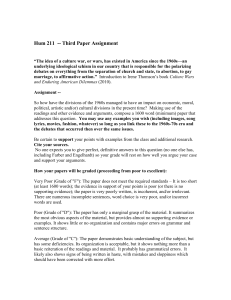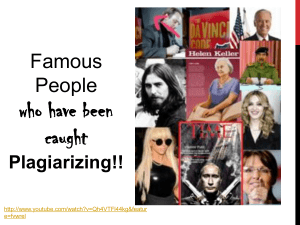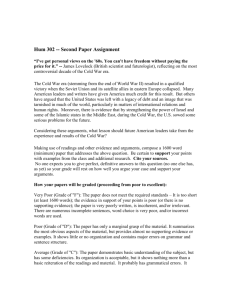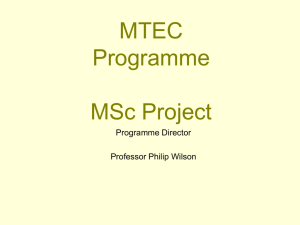UM Writing Center and Mansfield Library Best Practices for
advertisement
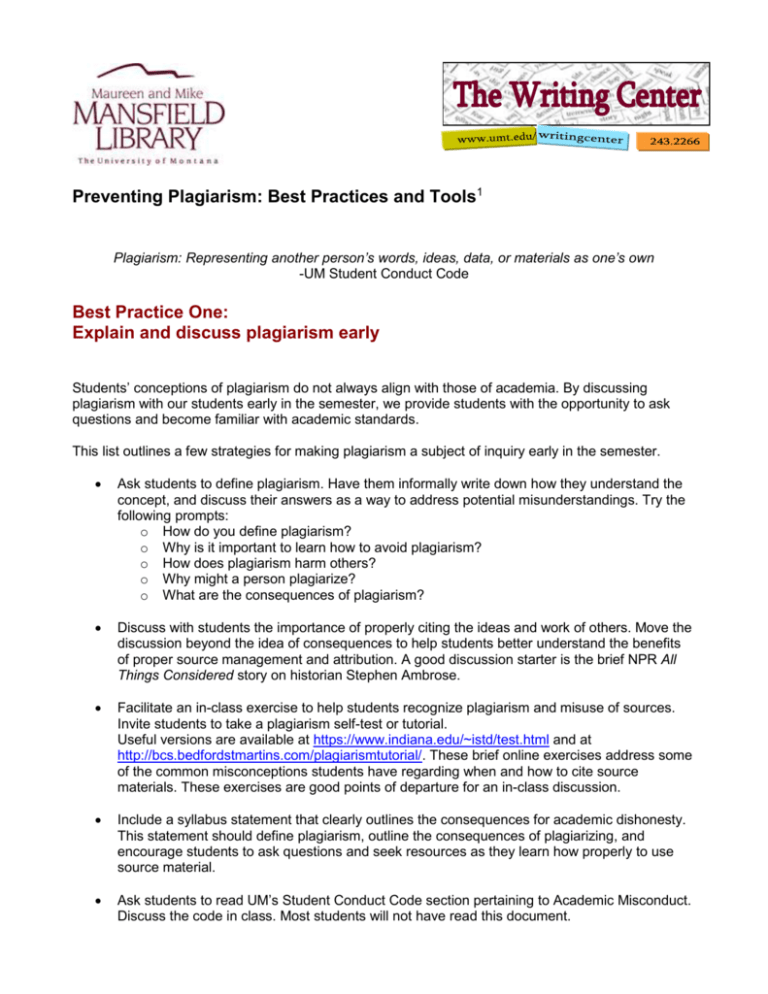
Preventing Plagiarism: Best Practices and Tools1 Plagiarism: Representing another person’s words, ideas, data, or materials as one’s own -UM Student Conduct Code Best Practice One: Explain and discuss plagiarism early Students’ conceptions of plagiarism do not always align with those of academia. By discussing plagiarism with our students early in the semester, we provide students with the opportunity to ask questions and become familiar with academic standards. This list outlines a few strategies for making plagiarism a subject of inquiry early in the semester. Ask students to define plagiarism. Have them informally write down how they understand the concept, and discuss their answers as a way to address potential misunderstandings. Try the following prompts: o How do you define plagiarism? o Why is it important to learn how to avoid plagiarism? o How does plagiarism harm others? o Why might a person plagiarize? o What are the consequences of plagiarism? Discuss with students the importance of properly citing the ideas and work of others. Move the discussion beyond the idea of consequences to help students better understand the benefits of proper source management and attribution. A good discussion starter is the brief NPR All Things Considered story on historian Stephen Ambrose. Facilitate an in-class exercise to help students recognize plagiarism and misuse of sources. Invite students to take a plagiarism self-test or tutorial. Useful versions are available at https://www.indiana.edu/~istd/test.html and at http://bcs.bedfordstmartins.com/plagiarismtutorial/. These brief online exercises address some of the common misconceptions students have regarding when and how to cite source materials. These exercises are good points of departure for an in-class discussion. Include a syllabus statement that clearly outlines the consequences for academic dishonesty. This statement should define plagiarism, outline the consequences of plagiarizing, and encourage students to ask questions and seek resources as they learn how properly to use source material. Ask students to read UM’s Student Conduct Code section pertaining to Academic Misconduct. Discuss the code in class. Most students will not have read this document. Best Practice Two: Craft plagiarism-unfriendly assignments and sequence them appropriately The following two approaches not only act to prevent plagiarism but also embody best practices for inviting students to engage with course material through research and writing. Design Effective Assignments A carefully designed assignment can both prevent opportunities for plagiarism and promote the kind of writing we hope students will produce. By designing inquiry-based assignments and including key variables in our assignments, we can help students avoid plagiarism and authentically engage with course materials. Sequence Assignments Appropriately Ask students to make their writing processes visible by requiring evidence of their thinking, researching, and writing steps along the way. These process requirements do not necessarily need to increase your grading load, but they should be built into the assignment and collected. By asking students to work on their writing assignments “in chunks,” we not only reduce the likelihood of plagiarized work but also encourage revision over time. The following strategies for chunking assignments are excerpted from John C. Bean’s book Engaging Ideas: The Professor’s Guide to Integrating Writing, Critical Thinking, and Active Learning in the Classroom (33-34). Intervene in the writing process by having students submit something to you. Take advantage of the summarizable nature of thesis-based writing by having students submit to you informal pieces of writing such as problem proposals, potential source lists, annotated bibliographies, tentative thesis statements, or self-written abstracts. Use these pieces of writing to identify persons who need extra help. Require students to keep a research log. Requiring that students keep track of and reflect on or annotate source materials as they read and write helps them understand the importance of effective source management. Build process requirements into the assignment, including due dates for drafts. If students are going to stay up all night before a paper is due, make that an all-night session for a mandatory rough draft rather than for a finished product. Develop strategies for peer review of drafts, either in class or out of class. After students have completed a rough draft, well in advance of the final due date, have students exchange drafts and serve as “readers” for each other. Require students to submit all drafts, notes, and doodles along with final copies. Have students staple their final copies on top of draft material arranged chronologically like geological strata. Not only will you have evidence of your students’ writing process, but you will also set up a powerful defense against plagiarism. Bring in examples of your own work in progress so that students can see how you go through the writing process yourself. Students like to know their teachers also struggle with writing. The more you can show students your own difficulties and strategies as a writer, the more you can improve their own self-images. Build adequate talk time into the writing process. Students need to converse among themselves, to bounce ideas off each other, to test arguments, and to see how audiences react. Another effective method for focusing students’ attention on the writing process is requiring them to submit a “metalearning essay” (Harris 57). In these exploratory pieces of writing, a student outlines his thinking, researching, and writing process. These informal pieces of writing not only encourage a student to more critically consider her choices as a writer but also provide you with information about the process the student used in producing the paper. During the writing process: By having students submit an exploratory essay prior to submitting the final paper, you can invite them to propose a problem or question and explore possible solutions or answers. This can help students to understand research as a problem-posing and problem-solving endeavor that requires that they postpone their conclusions until after engaging with the necessary materials. For example, you might ask students to consider these questions: O What is your narrowed topic? O What problem regarding this topic do you want to solve? What question regarding this topic do you want to answer? O Do you have a tentative solution or answer? O Where might you find information to help you solve this problem or answer this question? O What so far in your writing and researching process has been most difficult? After the writing process: By having students submit an exploratory essay after completing the assignment, you can invite them to reflect on the research strategies they followed and the learning that took place. Robert Harris suggests some sample prompts in his book The Plagiarism Handbook (57-58): O What problems did you face and how did you overcome them? O What research strategies did you follow? O Where did you find your sources? O What is the most important thing you learned from investigating? Best Practice Three: Promote effective reading and source management Discuss and Model Reading and Source Evaluation Strategies Explain to students how you go about reading and evaluating source materials. Provide them with the tools they need to be critical consumers of information. Provide students a low-stakes opportunity to engage their sources before they submit their final draft. Emphasize Purposeful Use of Source Material Even when students do accurately indicate where their own ideas end and another’s ideas begin, they do not always use their source materials in purposeful ways. We can help students engage with their source material in more meaningful ways by: demonstrating the ways in which experienced writers use source material. encouraging them to ask key questions of their sources and to focus on how their sources help to advance their arguments. introducing them to “they say/I say” templates (Graff and Berkenstein). Emphasize Accurate Citation Practices Students do not always understand how and when to accurately cite source material. For these students, incidents of plagiarism may be unintentional. By providing students with examples of how and when to cite, we help to correct their misconceptions about: how to use a specific citation system. when to cite and how to successfully use summary, paraphrase, and quotation. Make Students Aware of Technical Tools Available to Them Encourage students not only to use the Library faculty and Writing Center tutors but also to take advantage of the technical resources available to them as they execute searches and manage their findings. These include Refworks, EndNote, and other tools within the databases. Best Practice Four: Know and use your faculty resources Take advantage of the resources available to you as you design your assignments and classroom activities. Consult with library faculty and Writing Center staff, and refer to reliable sources for ideas that will support your teaching. These resources include: Mansfield Library faculty liaisons Writing Center staff Books and articles focused on best practices (see source list below for a few) Online pedagogical resources University Student Conduct Code ------------------------1 Handout Sources: Bean, John C. Engaging Ideas: The Professor’s Guide to Integrating Writing, Critical Thinking, and Active Learning in the Classroom. San Francisco: Jossey-Bass Publishers, 2001. Print. Graff, G. and Berkenstein, C. They Say, I Say: Moves that Matter in Academic Writing. New York: W.W. Norton & Company, 2009. Print. Harris, Robert A. The Plagiarism Handbook: Strategies for Preventing, Detecting, and Dealing with Plagiarism. Los Angeles: Pyrczak Publishing, 2001. Print. “Defining and Avoiding Plagiarism: The WPA Statement on Best Practices.” Council of Writing Program Administrators. Jan. 2003. Web. May 2012. Writing@CSU. Colorado State University, 2012. Web. 3 May 2012.


